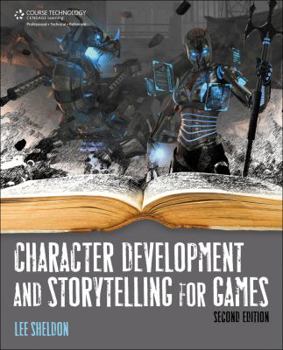Character Development and Storytelling for Games
Select Format
Select Condition 
Book Overview
This is the third edition of Character Development and Storytelling for Games, a standard work in the field that brings all of the teaching from the first two books up to date and tackles the new... This description may be from another edition of this product.
Format:Paperback
Language:English
ISBN:1435461045
ISBN13:9781435461048
Release Date:April 2013
Publisher:Cengage Learning
Length:538 Pages
Weight:2.38 lbs.
Dimensions:1.3" x 7.4" x 9.1"
Customer Reviews
4 ratings
Outstanding, but not what I expected
Published by Thriftbooks.com User , 16 years ago
Cons: The book seemed slightly long for what it was, kept reusing the same semi-obscure examples from the writer's experience, and didn't always go in the directions I wanted it to go (for example more detail on world building, settings, or individual story scenes would have been appreciated). Pros: It didn't matter that it didn't go where I wanted it because it was still very entertaining and unexpectedly beneficial to follow the writer on his path. The book is solid from start to finish and doesn't have a false air of superiority about it; everything is very practical and friendly. Definitely a good read that rewards the effort.
Excellent
Published by Thriftbooks.com User , 17 years ago
This book is excellent. Sheldon is witty and insightful and his book is a joy to read. I can't really think of anything negative to say, although I should perhaps mention that this book is pretty focused on RPGs and adventure games, since these are the genres which have traditionally relied most on story. Anyone interested in developing their understanding of storytelling in games should definitely pick this book up.
Breaking through barriers
Published by Thriftbooks.com User , 17 years ago
I am working on forming a game development studio, and our team is in the middle of producing our flagship title, an RPG entitled "Revolution's Dawn." I am the main writer of the script, and I just recently finished reading this book. Where I thought my duties as a writer were finished, I now see new openings to provide dialogue and sidequests to fill in the backstory, plot gaps, and other means of enrichment that I didn't see before. Because of having read this book, my team and I can now take this game and bring it into the realm of what we intended it to be-a vehicle for telling a story. While the title of the book is "Character Development and Storytelling for Games," the book really focuses more heavily on the latter. I was expecting the former, but by no means am I complaining! I have been able to break through blocks in my own role as a writer for this project. If you are looking for the "right" way to write your story, you won't find it here. What this book does instead is to open doors, and then let you decide whether to walk through them or not. And even then, you still have to choose for yourself what to do once you've walked through them. If you are looking for new openings in crafting your game _and_ writing your story(and synthesizing them both together), this is the book for you.
An excellent book for all writers
Published by Thriftbooks.com User , 19 years ago
I've known Lee Sheldon for several years. He is one of the most pleasant and knowledgeable people I've met in the game industry, so I was very much looking forward to this book. Suffice it to say that I wasn't disappointed. Writing for games has a lot in common with writing for other media (e.g., character and theme) and a lot that is unique to itself. Lee does an excellent job of covering both aspects - so much so that I would recommend this book to writers with absolutely no interest in interactive media. (I've read my share of writing books over the years, and this one stands at the top of the heap.) Of particular interest to me were chapters 3-6 on character and chapter 14 on modular storytelling, the most elegant way I've seen of organizing a linear experience into a non-linear structure. The book also does an excellent job of discussing storytelling in massively multiplayer games and provides extensive background material, much of which is intended to set up and justify Lee's modular storytelling model - rather more background than necessary, actually, since you should be sold on the need for something like modular storytelling long before he gets around to explaining it. The book's does have a few faults. For example, a couple of the later chapters feel out of place, and the text is dusted with a handful of puzzling and sometimes repeated typos (Eowen? Kalishnakov?) But these are of little consequence and should not detract from your enjoyment. Highly recommended.





